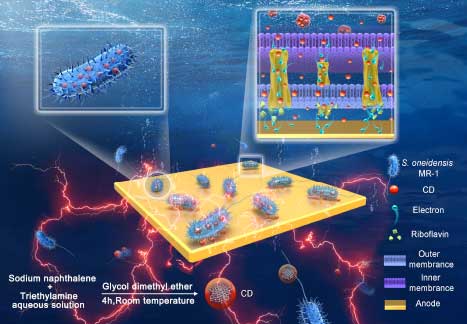| Mar 19, 2020 | |
Powering up bacteria for green electricity |
|
| (Nanowerk Spotlight) Bacteria are often associated with undesirable conditions of hygiene and health. Most of the time, the fear from bacterial harm overshadows their beneficial uses like the production of yoghurt, cheese, bread, vinegar and certain vaccines as well as their essential role in our survival by being a part of the gut. | |
| Our international multidisciplinary group of researcher from China, Denmark and Turkey undertakes the responsibility of giving bacteria a good name as an alternative green energy source. In our work, we identify the potential of using nanoscale carbon dots on Shewanella oneidensis MR-1 bacteria for augmented bioelectricity production. | |
 |
|
| Illustration of the synthesis of the carbon dots and the carbon-dots-fed S. oneidensis MR-1 for enhanced bioelectricity generation. (Reprinted with permission by Nature) (click on image to enlarge) | |
| Reporting our findings in Nature Communications ("Carbon dots-fed Shewanella oneidensis MR-1 for bioelectricity enhancement"), we demonstrated a novel method for significantly increasing the bacterial bioelectricity generation and applied it to set up microbial fuel cells. | |
| "Enhanced microbial fuel cells can potentially be used to aid energy-related issues while overcoming the troubles of other green energy alternatives such as dependency to geographical conditions," says Prof. Miao Yu, one of the Chinese corresponding authors of the study from Harbin Institute of Technology. | |
| Shewanella oneidensis MR-1 absorbs and reduces metal ions which makes it an ideal candidate for wastewater treatment. Moreover, while it reduces metal ions, it generates electricity, although not enough. | |
| Therefore, there have been attempts to increase its electricity production, for example, by genetic engineering or oligoelectrolyte intercalation. | |
| "We hypothesized that instead of using previously tried high-cost and -complexity methods, introducing a highly-conductive, biocompatible 0D nanomaterial with certain surface functional groups, can be more effective and organism-friendly," explains Prof. Yu. "Thus, we fed carbon dots to S. oneidensis MR-1 microbes which decorated the cells at an extra- and intra-cellular level." | |
| The enhanced microbial fuel cells of S. oneidensis MR-1 showed that using carbon dots can increase the maximum current value and power output by ∼7.34 and 6.46 fold! | |
| When we saw the first numbers, we immediately realized the one of a kind potential to study the origins of microbial bioelectricity and how to improve upon it. | |
| The in-depth investigations reveal that carbon dots increased the overall electronegativity of the microbes by incorporating in various internal and external structures. Carbon dots increased cellular adhesion, which in turn increased the biomass on the anode of the microbial fuel cell hence facilitated better electron transfer. | |
| Our results show that carbon dots' highly conductive carbon core not only improved overall systemic electrical conductivity but could also increase the packing density of the electron transfer path. | |
| In the experiments with mutant cells ΔOmcA/MtrC lacking electron transfer chain components, carbon dots successfully restored the charge path by insertion. | |
| Interestingly, according to our findings, carbon dots??? incorporation accelerated the cells??? metabolic rate and flavin production, which in turn raised electron generation and transport rate – however, the details as to how remain an open question. | |
| In our study, carbon dots are used to significantly improve the bioelectricity production of S. oneidensis MR-1 microbial fuel cells. These findings can contribute to next-generation energy systems, wastewater treatment and related fields. | |
| Producing electricity from waste is not only a portable green energy solution but in the big picture of things, it is critical to establish a global circular economy. | |
|
By Ast. Prof. Dr. H??sn?? Aslan, Interdisciplinary Nanoscience Center (iNANO), Aarhus, Denmark
|
|
|
Become a Spotlight guest author! Join our large and growing group of guest contributors. Have you just published a scientific paper or have other exciting developments to share with the nanotechnology community? Here is how to publish on nanowerk.com. |
|
